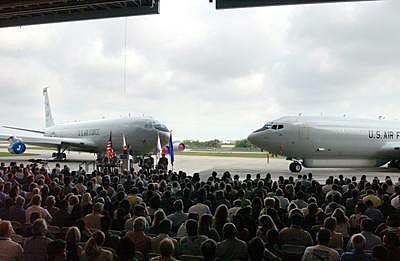17th E-8C Assigned To Georgia Air Guard
Northrop Grumman Corporation delivered the 17th and final
production E-8C Joint Surveillance Target Attack Radar System
(Joint STARS) aircraft to the US Air Force Wednesday.
Like all Joint STARS, the aircraft will be assigned to the
Georgia Air National Guard's 116th Air Control Wing (ACW), a "total
force blended wing," based at Robins Air Force Base, Warner Robins,
Ga., made up of both active duty Air Force, Army and Air National
Guard personnel.

"Joint STARS will be in the Defense Department's intelligence,
surveillance and reconnaissance constellation for many years to
come," said Dave Nagy, the company's Joint STARS program vice
president. "The next step now is to increase its value with
connectivity enhancements to existing and future systems while
simultaneously enriching the on-board support to the
warfighter."
The E-8C Joint STARS is the world's most advanced wide-area
airborne ground surveillance, targeting and battle management
system. It detects, locates, classifies, tracks and targets hostile
ground movements, communicating real-time information through
secure data links with Air Force and US Army command posts.
The first Joint STARS aircraft, delivered in 1996, is just
completing its upgrade to the Block 20 Computer Replacement Program
design. When the remaining two aircraft complete this commercial
off-the-shelf (COTS) this year, the entire fleet will be in the
same system configuration. "The wing is very close to having the
maximum number of these low-density, high-demand aircraft in the
same flexible, open system configuration, clearing the way for
affordable mission upgrades well into the future," Nagy said.
The Block 20 configuration features an integrated COTS computing
and signal processing architecture that can be easily upgraded with
new technology. This "open" architecture allows the E-8C's hardware
and software to be upgraded cost-effectively to meet future
surveillance, targeting and battle management requirements.
"P-17 is the most advanced aircraft we've delivered so far,"
said Nagy. "One of the critical needs identified in Operation Iraqi
Freedom was for more satellite communication (SATCOM) elements.
P-17 includes an upgraded SATCOM radio that allows the Joint STARS
to transmit and receive UHF SATCOM voice and digital data to
beyond-line-of-sight locations."
Besides SATCOM and the increased processing capability of the
Block 20 configuration, P-17 is also being delivered with a new air
traffic management capability known as Reduced Vertical Separation
Minimum (RVSM). Using RVSM, the Joint STARS aircraft can reduce the
required distance between it and other aircraft sharing the same
airspace allowing it to safely fly more optimal routes, gain fuel
savings and increase airspace capacity. The airplane also contains
a new weather radar.
All Joint STARS aircraft are based on a Boeing 707 airframe.
"Each went through a $40 million refurbishment program at the
Northrop Grumman production facility in Lake Charles, LA," said
Nagy.
This program consists of extensive inspection, treatment and
elimination of corrosion and the replacement of structural
components and panels as required. The aircraft are re-wired and
fuel tanks are stripped and re-sealed to increase aircraft
availability by preventing fuel leaks. The aircraft is brought into
compliance with all outstanding Airworthiness Directives/Service
Bulletins and Supplemental Structural Inspection Documents.

In addition, the Joint STARS' Wing Structural Integrity Program
(WSIP) addresses widespread fatigue damage that has been a problem
for other 707 airframes. WSIP replaces stressed lower wing planks
and stringers.
Nagy cited these and other investments during production and
frequent Programmed Depot Maintenance intervals as reasons why the
program management believes that Joint STARS is prepared to meet
warfighter commitments for years to come. The E-8C is programmed to
fly until 2025 and beyond as specified by Air Combat Command in the
Joint STARS Weapon System Master Plan.
In addition to producing Joint STARS aircraft, Northrop Grumman
provides a broad range of logistics and training support to the Air
Force under a Total Systems Support Responsibility (TSSR) contract.
The TSSR program is a unique partnership between the company and
the Air Force that maximizes the operational availability and
mission reliability of the E-8C Joint STARS fleet. It has also
helped ensure a seamless transition to the "blended wing" concept
under the 116th ACW.
"Our track record of exceeding our customers' expectations is
especially significant given the accelerating pace of operational
demand on the 116th Wing personnel and equipment," said Nagy. "The
Air Force has recognized our management of the TSSR program by
continually adding years to the contract at the end of every
periodic review. We are now contracted to support Joint STARS
through 2011." The TSSR program is designed for a potential run of
22 years.
Northrop Grumman's Integrated Systems sector leads the Northrop
Grumman Joint STARS development team. Norden Systems, a unit of
Northrop Grumman's Electronic Systems sector, manufactured all of
the Joint STARS radar sensors at its Norwalk, CT, facility.
 ANN's Daily Aero-Term (05.01.24): Say Altitude
ANN's Daily Aero-Term (05.01.24): Say Altitude ANN's Daily Aero-Linx (05.01.24)
ANN's Daily Aero-Linx (05.01.24) Classic Aero-TV: Korean War Hero Twice Reborn
Classic Aero-TV: Korean War Hero Twice Reborn Airborne 04.29.24: EAA B-25 Rides, Textron 2024, G700 Deliveries
Airborne 04.29.24: EAA B-25 Rides, Textron 2024, G700 Deliveries Airborne Affordable Flyers 05.02.24: Bobby Bailey, SPRG Report Cards, Skydive!
Airborne Affordable Flyers 05.02.24: Bobby Bailey, SPRG Report Cards, Skydive!




